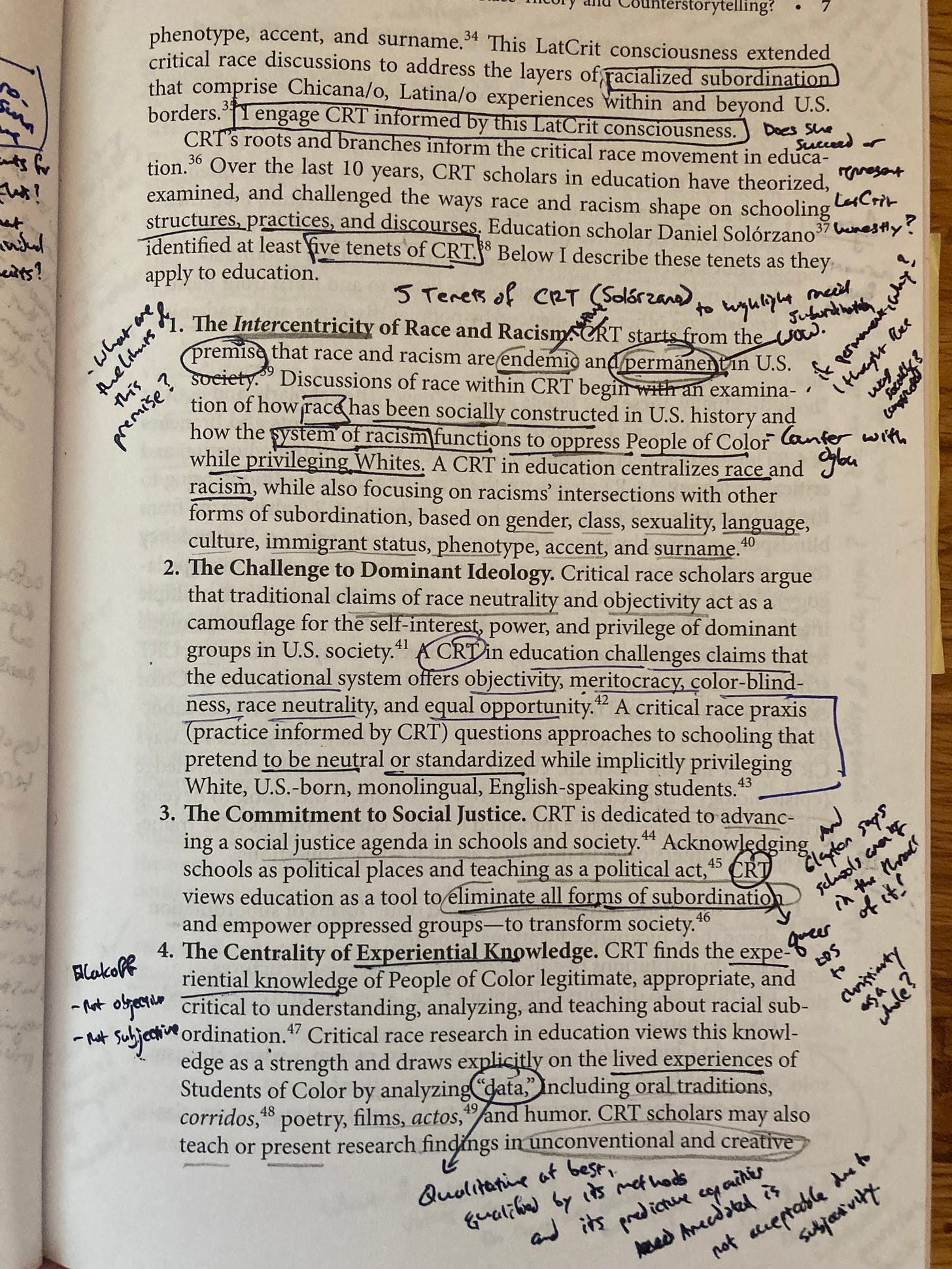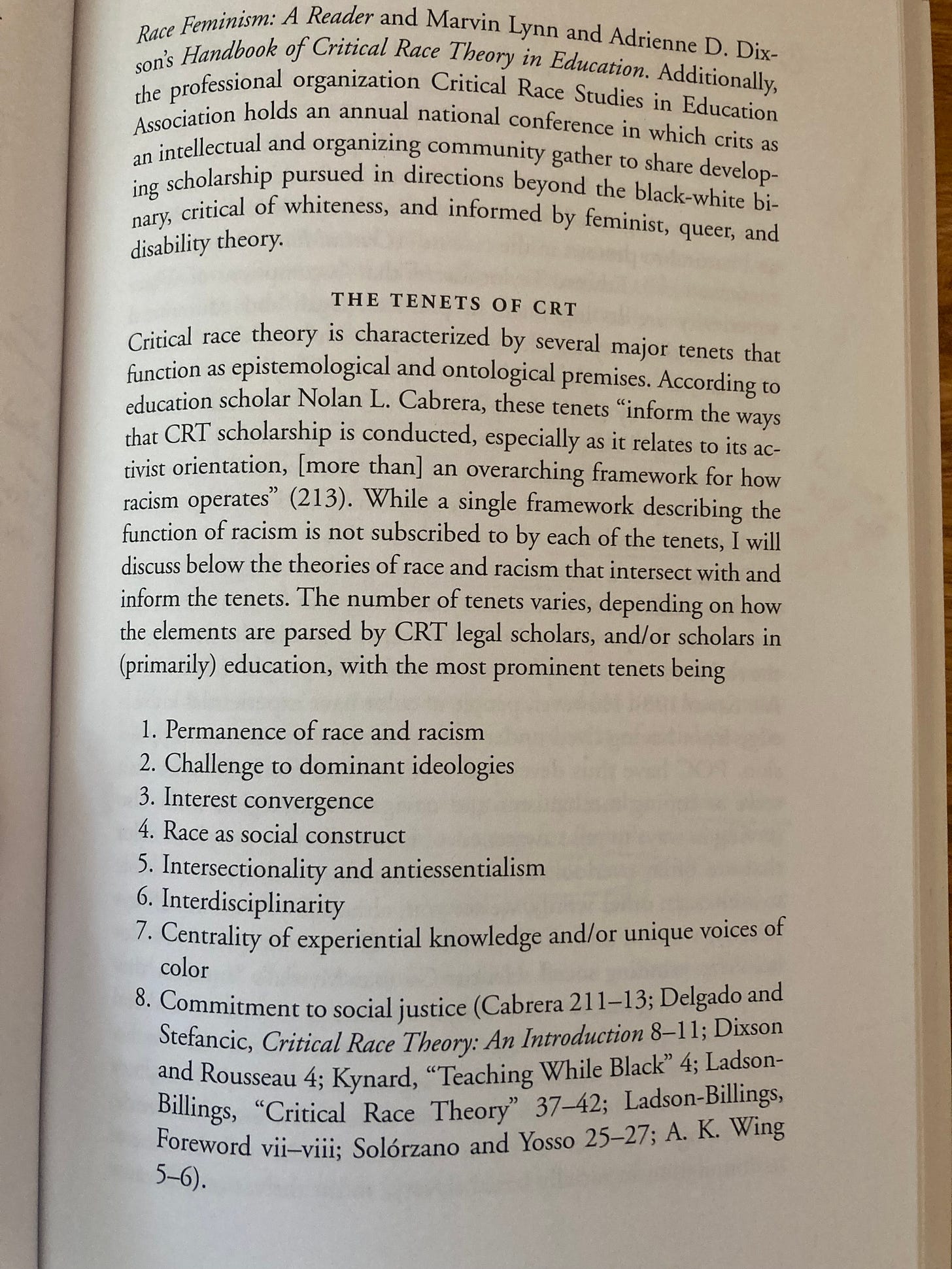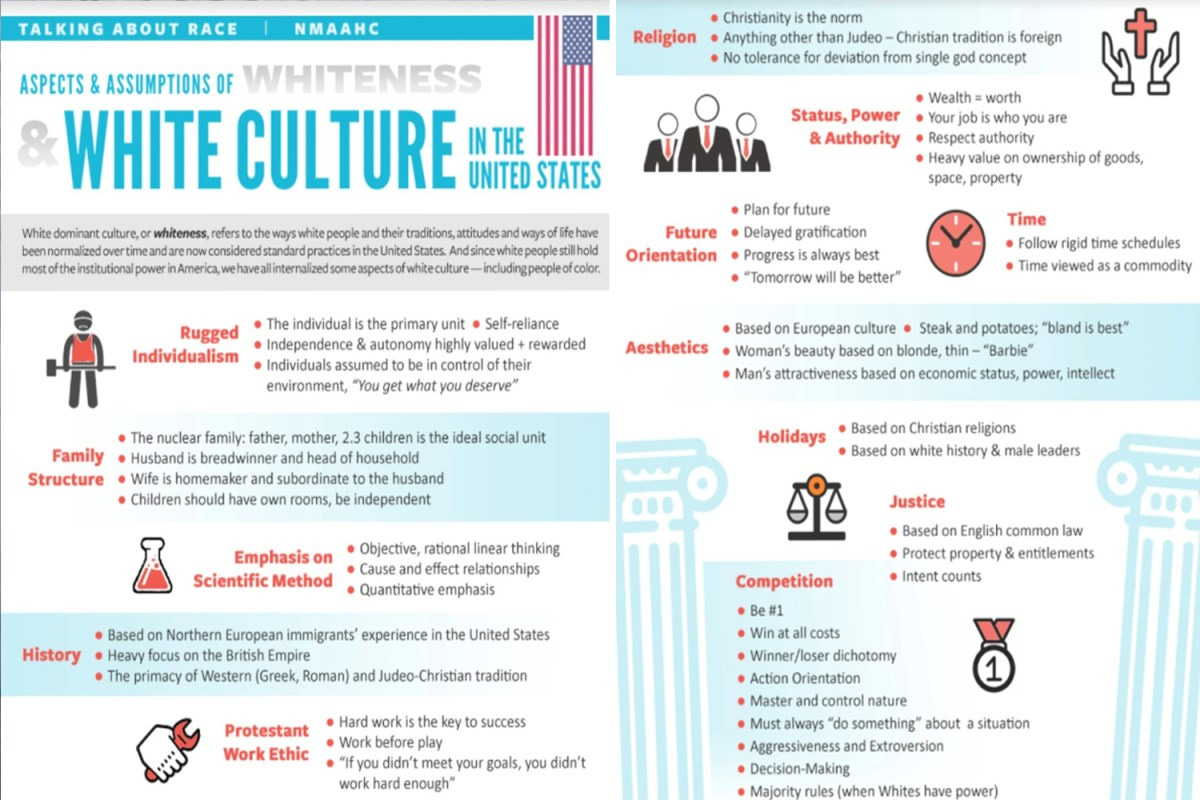CRT Tenets that Permeate Public School Curriculum and Media
All Educators Pursue Cultural Change (Improvement)...Yet How Does CRT Define and Pursue Such Change?
This article contains two parts:
Political and Media Denials of CRT in Schools
Fundamental CRT Tenets
Once you read this article, you will better understand and identify CRT and engage with people and neighbors who believe its race-relation descriptions.
Political and Media Representations and Deflections of CRT
Have you heard politicians like the 2021 Virginia gubernatorial candidate Terri McAuliffe brazenly assert in Clintonian demagogic discourse that CRT was a ‘right-wing conspiracy’? His own Virginia Department of Education listed several popular CRT-based texts as staff training and pedagogy development materials. Is CRT being taught in many K-12 schools? By now, you know that the answer is yes.
If you’ve heard the Mainstream Media talking heads state that CRT is only an obscure grad school theory whose theorists (Delgado, Crenshaw, Bell, & Kynard) no K-12 teacher teaches, then realize they are technically correct…and very wrong. But, CRT has jumped the grad school tracks to land in baby books and K-12 libraries, Nicole-Hannah Jones’s The 1619 Project, and in DEI staff trainings (which are everywhere).
If you’ve heard a neighbor say a group of white people lack diversity, then CRT and antiracism are behind it. If your kids’ teachers posit 1619 Project nostrums like America is fundamentally and permanently Racist rather than about novelly instituting a self-governing populace that corrects systemic Racism via constitutional reforms (amendments and civil rights), then they are learning CRT. Or, that white people only permit black and brown people their rights when doing so benefits white people, then you’ve heard CRT.
Also, if you’ve heard the simple argument below used to reference Thomas Sowell, Coleman Hughes, Larry Elder, Candace Owens, Sen. Tim Scott (R-SC), John McWhorter, Glenn Loury, Clarence Thomas, Ian Rowe, Erec Smith, Bob Woodson, and even Booker T. Washington, then you’ve heard CRT:
Left: racial definitions are socially constructed
Black Conservatives: we exist
Left: absolutely not! You can not socially construct yourself. We will. Racism is permanent. Act like it.
To some, they argue that right-wing media manufactured the 2021 backlash to CRT that has only grown since. And, as a media researcher, I know that media do construct realities for us all to consume yet also reflect actual events on the ground. My own two-part research into how media portrayed parent protests demonstrated how Left-wing media ignored parent voices and defended CRT being present in K-12 schools (as 5,000 k-12 teachers affirmed via the Zinn Education Project).
Others in education like the massive NEA union argue CRT opponents and conservative lawmakers are bullies for opposing CRT as the accurate approach to history its advocates think it is, that America’s defining heritage is systemic Racism. Because CRT involves criminal justice law and complex institutional funding and political discussions, some argue that:
the right-wing histrionics that CRT is being taught in primary and secondary schools strikes me as silly.
Sure. But like most people, most legal scholars have no idea CRT permeated my English Studies disciplines like English literature, Rhetoric and Writing, or Composition Studies nearly 40 years ago. And that NCTE, the flagship educational organization in America for K-12 and higher ed English teachers, regularly publishes leading books, journals, and conferences for elementary, middle, secondary, and college teachers to build their antiracist curriculum. K-12 teachers then commonly use these materials in their curriculum, lessons, and libraries to condition children (like my own 4 kids) to scapegoat American norms as products of whiteness and white people. If you’re a teacher, then I recommend supplementing with Bob Woodson’s empowering 1776 Unites curriculum to disrupt this orthodoxy and teach an empowering orientation to black history in America instead.
Fundamental CRT Tenets Used for Cultural Transformation or Social Justice
From my teacher training at Cal State San Bernardino MA in English Composition (18-20) and my current PhD in Rhetoric and Writing at Virginia Tech (2020-now), my professors used the following texts to instruct how to teach writing using CRT:
Critical Race Counterstories Along the Chicana/Chicano Educational Pipeline (2006) by Tara Yosso
Counterstory: The Rhetoric and Writing of Critical Race Theory (2020)by Aja Martinez
I first studied Yosso’s text as part of a Critical Pedagogy seminar in 2018 at CSUSB.
So you don’t have to decipher the tenets amongst my scribbles:
The Intercentricity of Race and Racism (racism is endemic and permanent)
The Challenge to Dominant Ideology (neutrality and objectivity are suspect)
The Commitment to Social Justice (classrooms and teaching are political)
The Centrality of Experiential Knowledge (experiential knowledge is legitimate)
The Interdisciplinary Perspective (multiple methods to tell history from the bottom in opposition to popular discourse and academic research)
Now, I actually agree with Yosso that education should discuss experience and tell ‘history from the bottom’ in addition to the top. Namely, with regard to CRT, I agree because advances toward civil rights exist precisely because U.S. constitutional law and legal practice have worked against and oppressed black people, brown people, and non-dominant race, gender, religious, and ethnic identities across state and national history. Narratively marginalized as well as legally oppressed. I do believe that public school classrooms are political by nature but should not be in practice. I don’t suspect objectivity enough to deny it but to recognize our perception of objectivity arises from limited subjective and socially constructed perspectives (replete with biases to acknowledge).
Yet trying to undo, ameliorate, or erase the disparate impact of slavery, Jim Crow, and mass incarceration, for example, should not require new legal discrimination (a la Ibram Kendi) in law and workplaces precisely because that breeds new discriminatory animosity, dominance, and oppression that got us all here in the first place, that no one today deserves.
In turning to Aja Martinez’s text, studied in a Theory of Writing PhD course, we see that she seeks to situate CRT generally, and the counterstory method (CM) specifically, as a pedagogical means to uncover racial bias of dominant narratives in the rhetoric and writing fields. She does so because she feels compelled as a minoritized voice who used CM to enter the academy to definitively identify and define for the disciplinary ‘gatekeepers’ what counterstory is (31) and to further write her way into the academy through a personalized tracing of a revisionist history of rhetoric and writing studies with critical race theory and counterstory methodology as her “guiding forces” (4). And yet the subjective quickly asserts its own unwarranted distorted truths about ‘dominant’ people. And via this ‘personal is political’ rubric, any ideology appears justified in politicizing classrooms to bend culture and curriculum to their will.
If CM is correct in seeking to counter erroneous dominant and majoritarian stigmas and stereotypes of marginalized peoples, as well as the negative effects those stories have on all people, then my main criticism of critical race counterstories and counterstory method is that they too easily stereotype white people, past and present. They create a minoritarian stereotyping of the race perceived to be culturally dominant. In CM research, white people (or males) often become caricatures, distant yet everpresent, dehumanized versions of some monolithic group of white people and experience; they also deny the marginal agency and heterodoxy found in the voices of dissenting conservative and liberal U.S. blacks and all minorities.
In other words, by portraying their cultural opponent in reductivist and essentializing ways, as in Marxist terms like cultural Whiteness (below), that very human opponent and its attendant cultural values and narratives easily become the oppressive Villain. I highly recommend watching Netflix’s 2023 Leave the World Behind because it condenses progressive CRT theory into a 2-hour Red Dawn-style apocalypse scenario. Most viewers watch it for the apocalypse genre and don’t grasp the utterly coherent and brilliant visual depiction of CRT Tenets that blame the apocalypse on White narratives and people.
Yet, ironically, this antagonistic framing of CRT, CM, and Obama-produced Netflix film, frustrates social justice work, for any rational opposition to its flawed meta-narratives and policy proposals then becomes distorted into white supremacy and irrational white fragility so much so that scholars (like my own Dr. Sano-Franchini) equate mere majority white presence in a city like Spokane, WA, to white supremacy worthy of citation justice (where scholarship cites non-white scholars).
Demographic data shows us that Spokane is a predominantly white place…Yet white supremacy so frequently overtakes and covers over the presence and persistence of minoritized people, and as a result, their histories, needs, concerns, and ways of knowing and being, rendering them scarce and seemingly insignificant. Why does white supremacy become the single story we tell about certain places?
Indeed. Why do ‘we’ only tell white supremacist stories about certain places? While arguing for ‘writing abundance’, each paper presentation this April must ensure it:
Practices citation justice. The proposal is situated in relation to existing scholarship and research in the field, and uplifts and amplifies Black, Indigenous, Asian, Latinx, and other multiply marginalized perspectives. The proposal may also describe how the presenters will learn from other minoritized communities to further their thinking about the topic.
So, CRT and CM argue that the White supremacy story has already been told, collapsing white heterodoxy into this category. And my discipline’s 2024 CCC conference theme argues white supremacy narratives and presence dominate in 2024 simply because white demographic majorities exist. But, why call for the telling of indigenous stories of Spokane at the expense of white stories, in a subtractive approach? Is that really ‘abundant’ cultural change?
I’ll finish with 3 Untold Academy stanzas expressing my PhD experience:
Designing dichotomy
to see all this leprosy.
White skin the sinful scales
Of minoritarian tales
Got the wrong identity?
Get back in your category.
Maintain the partisan Purity
while we accrue Assurity,
drunk on our authority,
derived from a tautology:
Where if I say I’m not racist
then I am for sure racist.
On this Kafka trap basis
rests my social stasis:
absence for safe spaces.







